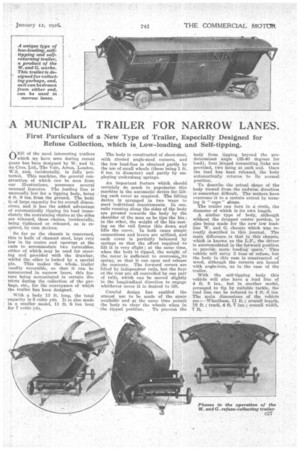A MUNICIPAL TRAILER FOR NARROW LANES.
Page 11

If you've noticed an error in this article please click here to report it so we can fix it.
• First Particulars of a New Type of Trailer, Especially Designed for Refuse Collection, which is Low-loading and Self-tipping.
nNE of the most interesting trailers V./which we have seen during recent years has been designed by W. and Cl. du Cros, Ltd., The Vale, Acton, London, W.3, and, incidentally, is fully protected. This machine, the general construction of which can be seen from our illustrations, possesses several unusual features. The loading line is unusually low for a tipping body, being 4 ft. 9 ins, from the ground. The body is of large capacity for its overall dimensions, and it has the added advantage of automatically tipping its load immediately the restraining chains at the sides are released, these chains, incidentally, being tightened or released, as is required, by cam devices.
So far as the chassis is concerned, this is built of channel steel, kept very low in its centre and upswept at the ends to accommodate two turntables, either of which may be used for steering and provided with the drawbar, whilst the other is locked by a special pin. This makes the whole trailer readily reversible, so that it can be manoeuvred in narrow lanes, this fealure being necessitated in certain districts during the collection of the garbage, etc., for the conveyance of which the trailer has been designed.
With a body n ft. long, the total 'capacity is S cubic yds. It is also made in a smaller model, 11 ft. 6 ins, long for 7 cubic yds.
The body is constructed of sheet-steel, with riveted angle-steel corners, and the low load-line is obtained partly by the use of small wheels (these being 1 ft. 6 ins. in diameter) and partly by employing underslung springs.
An important feature which should certainly do much to popularize this machine is the automatic device for lifting each cover as required. The lifting device is arranged in two ways to meet individual requirements. In one, rails running along the sides of the body are pressed towards the body by the shoulder of the man as he tips the bin; in the other, the weight of the bin resting on the rail forces this down and lifts the cover. In both cases simple connections and levers are utilized, and each cover is partially balanced by springs so that the effort required to lift it is very slight ; at the same time, when the body is tipped, the weight of the cover is sufficient to overcome.its spring, so that it can open and release the contents. The forward covers are lifted by independent rails, but the four at the rear are all controlled by one pair of rails, which can be moved slightly in the longitudinal direction to engage whichever cover it is desired to lift.
Careful design has enabled the utmost use to be made of the space available and at the same time permit the body to clear the wheels when in
the tipped position. To prevent the body from tipping beyond the predetermined angle (35-40 degrees for load), four hinged connecting links are provided, two being at each end. Once the load has been released, the body automatically returns to its normal position.
To describe the actual shape of the body viewed from the endwise direction is somewhat difficult. The makers have overcome it to a certain extent by terming it " cape " The trailer can turn in a circle, the diameter of which ia its own length.
A similar type of body, although without the dropped centre portion, is also being made for the new low loadline W. and Cl. chassis which was recently described in this journal. The main difference is that in this chassis, which is known as the L.F., the driver is accommodated in the forward position to provide more loading space.' This vehicle will carry 3 tons of refuse, but the body in this case is constructed of wood, although the corners are bound with angle-iron, -as in the case of the trailer.
With the self-tipping body this vehicle will also have a load line of 4 ft. 9 ins., but in another model, arranged to tip by suitable tackle, the load line can be reduced to 4 ft. 6 ins. The main dimensions of the vehicle are :—Wheelbase, 11 ft.; overall length, 18 ft.; track, 4 ft. 7 ins.; overall width, 7 ft.
































